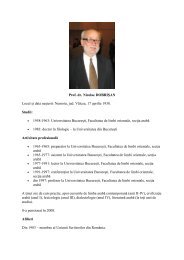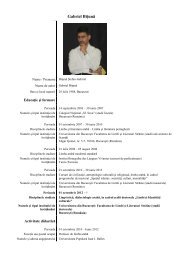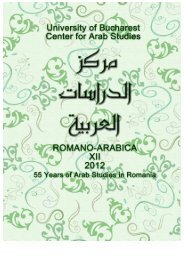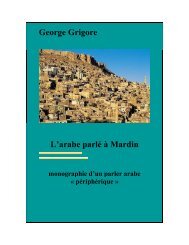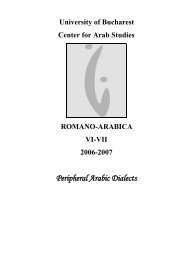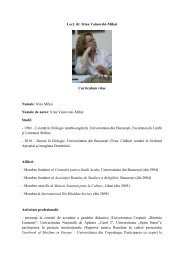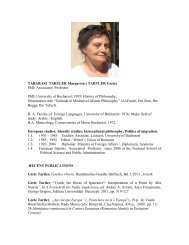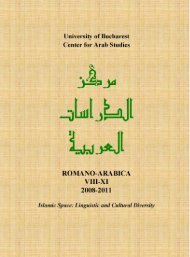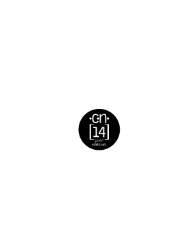Arabic Linguistics
Arabic Linguistics
Arabic Linguistics
You also want an ePaper? Increase the reach of your titles
YUMPU automatically turns print PDFs into web optimized ePapers that Google loves.
In conclusion, in light of the data from JA and N, the picture that emerges<br />
with respect to the role of tone in pidgins and creoles turns out to be more<br />
complex than assumed by McWhorter (1998, 2000 and 2003).<br />
7. Lexicalized compound nouns<br />
Lexicalized compound nouns, which occur rather frequently in pidgins and<br />
creoles, raise, among others, the issue of their origin. Consider, for instance,<br />
eyewater ‗tear‘, which is, according to Baker and Huber (2001: 198) a diagnostic<br />
feature of Atlantic English creoles.<br />
It is certainly true that this feature is ―extremely common both in Atlantic<br />
Creoles and in West African languages‖, as noted by Parkval (2000b: 113). Holm<br />
(1992: 191), for instance, mentions among others Igbo aŋa-mmiri, Twi ani-suo<br />
and Yoruba omi oju, all literally ‗eye water‘. It is equally true that ―[t]here are<br />
many lexemes in Afro-American dialects which reveal a labelling pattern whereby<br />
objects are named in terms of an association between two primary named objects‖<br />
(Alleyne 1980: 114). Therefore, eyewater may be one of the ―readily convenient<br />
calques from a number of African languages‖ Allsopp (1980: 91).<br />
However, a number of arguments can be adduced against tracing it back to<br />
an West African substrate language. First, according to Allsopp (1980: 91), ―each<br />
of those African bases was likely to have its own synonymous form which did not<br />
lend itself so readily to calquing‖. He further writes that e.g. ―Yoruba, in common<br />
with many West African languages, has the relevant compound omi ojú (<<br />
―water‖ + ―eye‖) ~ omijé (= ―a tear‖) but it is rarer than kún (= ―sorrowful<br />
weeping‖)‖ (Allsopp 1980: 91).<br />
Second, as shown in Avram (in press), the compound at issue is also attested<br />
in Tok Pisin, a Pacific variety of restructured English: aiwara ‗tears‘. It follows<br />
that eyewater ‗tear‘ should be reclassified as a world-wide feature.<br />
Third, a structurally identical compound noun occurs in both JA and N 15 :<br />
(67) móya ena JA (Miller 1993: 159)<br />
water eye<br />
‗eye‘<br />
(68) moy-ééna N (Prokosch 1986: 85)<br />
water eye<br />
‗tear‘<br />
Consider next the compound doormouth ‗threshold‘, which is also listed as<br />
a diagnostic feature of Atlantic English pidgins and creoles in Baker (1999: 330)<br />
and in Baker and Huber (2001: 198). It is widely assumed to be a calque of<br />
similar compounds in West African languages. Baker (1999: 330), for instance,<br />
35



